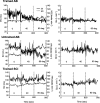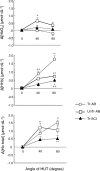Characteristics of cardiovascular responses to an orthostatic challenge in trained spinal cord-injured individuals
- PMID: 30268154
- PMCID: PMC6162881
- DOI: 10.1186/s40101-018-0182-x
Characteristics of cardiovascular responses to an orthostatic challenge in trained spinal cord-injured individuals
Abstract
Background: We investigated cardiovascular responses to an orthostatic challenge in trained spinal cord-injured (SCI) individuals compared to able-bodied (AB) individuals.
Methods: A total of 23 subjects participated, divided into three groups: seven were trained as spinal cord-injured (Tr-SCI) individuals, seven were able-bodied individuals trained as runners (Tr-AB), and nine were untrained able-bodied individuals (UnTr-AB). We measured the cardiovascular autonomic responses in all three groups during each 5-min head-up tilt (HUT) of 0°, 40°, and 80°. Stroke volume (SV), heart rate (HR), and cardiac output (Qc) as cardiovascular responses were measured by impedance cardiography. Changes in deoxyhemoglobin (∆[HHb]) and total hemoglobin (∆[Hbtot]) concentrations of the right medial gastrocnemius muscle were measured using near-infrared spectroscopy (NIRS).
Results: As the HUT increased from 0° to 80°, Tr-SCI group showed less change in SV at all HUT levels even if HR increased significantly. Mean arterial pressure (MAP) also did not significantly increase as tilting increased from 0° to 80°. Regarding peripheral vascular responses, the alterations of ∆[Hbtot] from 0° to 80° were less in Tr-SCI group compared to AB individuals.
Conclusion: There is a specific mechanism whereby blood pressure is maintained during a HUT in Tr-SCI group with the elicitation of peripheral vasoconstriction and the atrophy of the vascular vessels in paraplegic lower limbs, which would be associated with less change in SV in response to an orthostatic challenge.
Keywords: Cardiovascular responses; Near-infrared spectroscopy; Orthostatic challenge; Spinal cord injury.
Conflict of interest statement
Ethics approval and consent to participate
The experimental protocol was approved by the ethics committee of the Institutional Review Board of the Prefectural University of Kumamoto. All subjects provided written consent for their participation after they were fully informed about the study. The investigation was performed in compliance with the Declaration of Helsinki.
Consent for publication
We fully understand and agree to all the terms and conditions stated here by you. Thank you for your consideration of my submitted paper.
Competing interests
The authors declare that they have no competing interests.
Publisher’s Note
Springer Nature remains neutral with regard to jurisdictional claims in published maps and institutional affiliations.
Figures




References
MeSH terms
LinkOut - more resources
Full Text Sources
Medical
Research Materials

